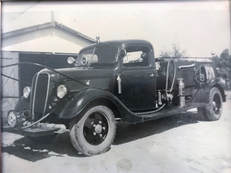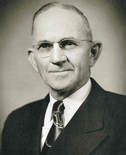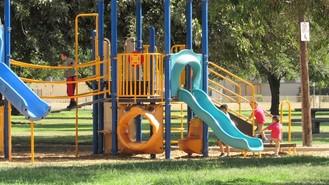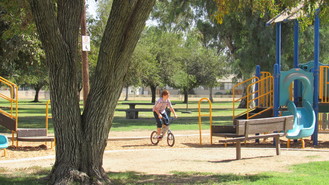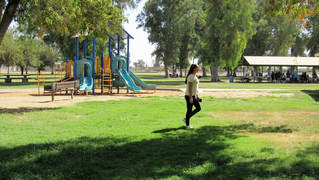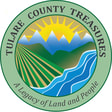|
"Parks have a value to communities that transcends the amount of dollars invested or the revenues gained from fees. Parks provide a sense of public pride and cohesion to every community." -- National Recreation and Parks Association
"The Pixley Chamber of Commerce, which has successfully petitioned for a new depot for Pixley and also secured a county fire truck with resident driver, has originated plans for a county park here, which, if the plan goes through successfully, will bring to Pixley the only county park in southwestern Tulare county." -- Pixley Enterprise, August 13, 1937
"The local Chamber of Commerce appointed a park committee . . . to work with a committee from the Pixley Community club . . . ." Members of these two committees and the Earlimart P.T.A., Tipton's Women's Club, Pixley Community Club, Pixley Grange, "Pixley United Brethern [sic] church and others interested, met the County Supervisors in session and presented their plan." -- Pixley Enterprise, August 13, 1937
"Judge Ellis of Alpaugh could not be present, but telephoned the supervisors that he was heartily in favor of the plan and he felt that if this part of the county were given more recreational advantages, his duties would be greatly lightened." -- Pixley Enterprise, August 13, 1937
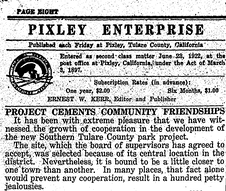
"The action by the board [of supervisors] at the Tuesday meeting is the culmination of much effort spent by people from this section, and previous propositions have been made to the county but were rejected due to economic conditions." -- Pixley Enterprise, April 22, 1938
" It has been with extreme pleasure that we have witnessed the growth of cooperation in the development of the new Southern Tulare County park project. . . . Tipton residents realize that the park will be just as much theirs as Pixley's. And Earlimart people that they will get just as much pleasure out of the playground as Tipton. And so on, through all the communities in the region." -- Pixley Enterprise, August 10, 1938
"All the other communities in the district will have a share in promoting the barbecue." Committees already appointed are: speakers committee, entertainment, sports, dance, concessions, publicity, and the barbecue cookery. "Various women's clubs of the district will be in charge of the serving." -- Terra Bella News, May 6, 1938
"Park committeemen who viewed the plans were well pleased with the arrangement, and as work commences on the ground people will the more realize the advantage of the beauty spot for this section of the county." -- Pixley Enterprise, June 22, 1938
"It is doubtful if any one thing is enjoyed by more people than our parks . . . The people to the south are to be congratulated upon envisioning and perfecting the plan for a new park in that area, and the board of supervisors is to be complimented for realizing its value and giving full support to the project." -- Tulare Advance-Register, April ?, 1938
"This park has proved to be a most welcome haven from the heat of our numerous trips down the Central Valley. We have enjoyed picnic lunches in its clean surroundings and our daughter has played on the equipment. Thank you again. Yours sincerely, Mrs. Robert A. Post, Long Beach, CA, October 22, 1963"
Photos for this article by: Laurie Schwaller, and courtesy of California State Library, California History Room, Hamilton Henry Dobbin photo, circa 1892; Google Earth; Library of Congress; National Archives and Records Administration; Peter Neeley/My Old Tulare County Pics; Tulare County Fire Department, Pixley, CA; Tulare County Library, Annie R. Mitchell History Room; and Tulare County Parks and Recreation
|
PIXLEY PARK
Environment: Valley, 1/2 mi. NE of Pixley; 22 acres; lots of trees Activities: birdwatching, disc golf, dog walking (on leash), history, photography, picnicking, playground, rest stop, soccer Open: Summer (June 1 - September 8) 8:00 a.m. - 8:00 p.m. except closed on Tues. and Wed.; Fall (Sept. 9 - Oct. 31) 8:00 a.m. - 5:00 p.m. on Mon., Thurs., and Friday; 8:00 a.m. - 7:00 p.m. on Sat. and Sun. (closed on Tues. and Wed.); Winter (Nov.-Feb.) 8:00 a.m. - 5:00 p.m., except closed Tues. and Wed.; Spring (Mar.-May) 8:00 a.m. - 5:00 p.m. on Mon., Thurs., and Fri., 8:00 a.m. - 7:00 p.m. on Sat. and Sun. (closed on Tues. and Wed.). Reservations for picnic arbors taken throughout the year. No entrance fee. Site Steward: Tulare County Parks and Recreation Division - 559-205-1100; same number for reservations. Contact Site Steward for Arbor fees Opportunities for Involvement: donate, volunteer Links: https://tularecountyparks.org/park-cards/ Directions: Map and directions are at the bottom of this page. History:
Pixley Park: Serving the Southwest County and Travelers from Near and Far by Laurie Schwaller By 1937, Tulare County boasted four large county parks. Mooney Grove and Cutler, near Visalia, and Bartlett and Balch, accessed from Porterville and Springville, regularly attracted large crowds and offered many amenities. But the southwest county had only Alpaugh's little 2-acre park, which was much too small to serve the area's growing population. The Pixley Chamber of Commerce determined to remedy this situation by adding a substantial county park in Pixley. Located on Highway 99, Pixley was central to the communities the park would serve, including Alpaugh, Angiola, Ducor, Earlimart, Edendale, Saucelito, Terra Bella, and Tipton. The Chamber appointed a committee to work with the Pixley Community Club to promote the plan, and in a remarkably cooperative effort, the surrounding towns, instead of squabbling over which should host the park, joined in supporting Pixley's campaign.
The committees advertised for a site and soon received an offer of a 20-acre tract a half mile north of town beside the highway. The $750 price was a lot of money in the Great Depression, but Jay G. Brown, newly-appointed Supervisor of the Fifth District, offered his support and advised the park advocates to present their case to the County Board of Supervisors. The Supervisors admitted the need for the park and discussed how it might be financed. In August, at Supervisor Brown's request, County Parks Superintendent R. B. (Bob) Tucker visited Pixley and concluded that trees and shrubs could be furnished from the Mooney Grove nursery while lumber for the park attendant's home, fences, and restrooms could be provided from the county's Balch Park saw mill, greatly reducing development costs. In April, 1938, the Supervisors unanimously adopted a resolution to accept the proposed parkland. Following Porterville's example, the communities would raise the money to buy the land, then deed it to the county, which would develop and maintain the park. The Pixley Chamber promptly appointed a Ways and Means committee to raise the funds.
The very next week, Supervisor Brown and Superintendent Tucker inspected the site to work out a budget for the park. Their report had to be submitted before the county's fiscal year ended on June 25th for the park's development to be funded in the 1938-39 budget. Otherwise, construction would be delayed for a year. Tucker estimated it would take about $3,500 to make the park land ready. He included an entrance gate, roads and parking areas, fences, a caretaker's cottage, two "thoroughly modern" restroom facilities, lights, and a storeroom. A pump house and irrigation system would distribute water from the existing 200-foot well. The county would apply for help from the Works Progress Administration (WPA), the New Deal public works program. Fund-raising began immediately, along with work to clear stumps, rubbish, and weeds from the site. Superintendent Tucker planned to top and trim the existing trees, to transplant at least a hundred oaks to the park to provide permanent shade, and to fill in the area with more fast- growing trees while the oaks matured.
Tucker and County Surveyor Wayne Switzer surveyed the site and prepared detailed drawings of what the park would look like within twelve years. Meanwhile, the communities that the new park would serve decided to raise money with a barbecue picnic and festival to be held at the park grounds on June 2. On that day, the new Southern Pacific Railway station at Pixley was being dedicated, with Governor Frank Merriam invited to speak. A crowd of over 1,000 was expected, so for a $1.00 admission, many people would be able to see the park site and help raise the $750 to pay for it. In May, a large road camp crew was at work readying the site for the June event, which would start after the 10:00 a.m. depot dedication. The program committee had arranged for music by the Delano band, an old fiddlers' contest, track events, contests, and sports in the afternoon, followed by an evening dance at the Soares dance hall. The menu for the BBQ dinner was set, and cold drinks stands and concessions would dot the grounds. The big day was a success. The money was raised, the land was purchased and turned over to the county, and the park plans were finalized. The project got a huge boost in October when the County learned that the WPA had approved $7,045 for park improvements. Along with $2,538 of county money, the funds would be used to complete the clearing, grubbing, and grading , construct the buildings and infrastructure, add landscaping and drinking fountains, and perform "incidental and appurtenant" work.
Superintendent Tucker's plan for the park showed two entrances and the caretaker's house in the middle with roadways radiating from it out to the corners. Parking facilities and 20 picnic tables with benches were scattered throughout, with restrooms near the caretaker's house. Other amenities included an arbor, a playground, a ball park, and a big barbecue pit in the southeast corner. The pumping plant, the caretaker's quarters, and the restrooms would be constructed first, with other improvements made "as fast as funds are available." Work began in mid-November, with 23 WPA men, Superintendent L.C. Canaday of Tulare, and two county men on the site. The park caretaker had been hired and was on the job along with a carpenter from Mooney Grove Park building the 24'x26' caretaker's house. Six months later, on June 2, 1939, when the second annual fundraising barbecue and dance for the park was held, the program included the park's opening and dedication service, followed by an amateur talent contest and a ball game. The Park Booster Club sold tickets for 50 cents, with the proceeds going into the treasury for a lighted ball field. At the third annual park BBQ, in June, 1940, the new lighted ball diamond was dedicated. The united efforts of the southwest district's communities, with considerable help from the county and the WPA, had achieved all their original goals for their park, a very bright spot in those dark Depression days. Now, over 80 years since the people of Pixley envisioned a park in their future, that green open space continues to serve not only southwest county residents, but also thousands of travelers seeking a respite from hectic Highway 99. They come to enjoy a stretch outdoors, walk their dogs, let their kids run free or exercise on the playground equipment, participate in sports, socialize, celebrate a special event, or have a picnic in the shade of its many trees. Next time you're passing through Pixley, stop and join them -- and check out the granite marker near the park entrance to learn some history. A famous train robbery occurred nearby in 1889!
October, 2018 Directions:
Address: 950 N. Park Dr., Pixley, CA; located 1 mile NE of Pixley on Road 124, adjacent to Hwy 99. From Visalia, take Hwy 99 south to just north of Pixley. Take the Main Street exit (70C) south into Pixley. Turn left (east) onto E. Court Ave. and cross over the freeway. Turn left (north) onto N. Park Drive and follow it to the park entrance on your right. |

